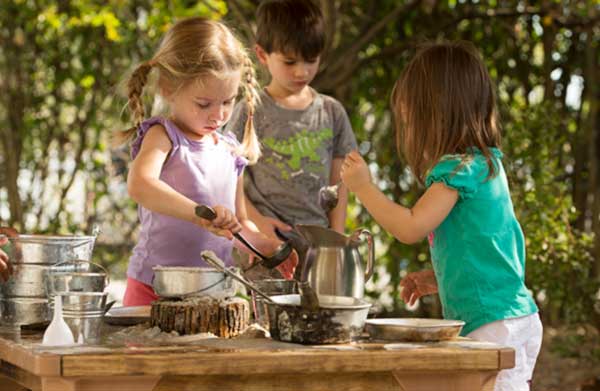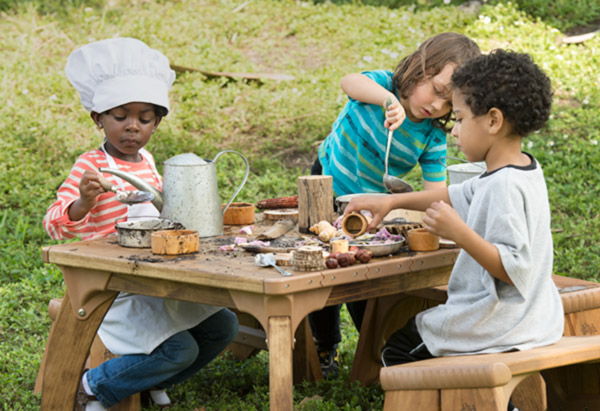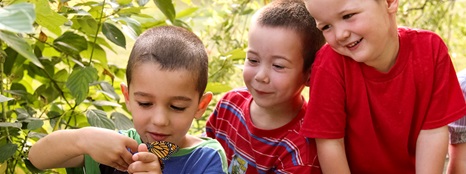Mud, marvellous mud!
| May 2017Oh the joys of mud! Since the dawn of time children have been drawn to mud puddles and dirt as a part of their play. Mixing soil, water, and other natural materials like pebbles, leaves, or grass provides children endless possibilities for learning and fun. Many of us have fond memories of creating mud pies, digging for worms, or making streams and valleys in the mud. But it’s not just about fun. Children benefit from messy, muddy play.
Benefits of mud play
Scientists have now confirmed something that children have always instinctively known; playing in mud is a joyful experience. Recent research has shown that dirt contains microscopic bacteria called Mycobacterium Vaccae which stimulates the immune system and increases the levels of serotonin in our brains, an endorphin that soothes, calms, and helps us to relax. Scientists say regular exposure to the bacteria may help reduce a child’s vulnerability to depression. In short, playing in mud makes you happier!
Playing in mud can make you healthier too. Science shows that today’s sanitised world is actually contributing to increased levels of childhood allergies and asthma. Exposure to dirt and germs works to prime a child’s immune system to prevent allergies. Yes, it’s actually healthy for children to get muddy!
Mud is also an excellent medium for learning. The same release of serotonin that occurs when playing in Mycobacterium Vaccae dirt has also been shown to improve cognitive function. And the rich, engaging sensory play children partake in while playing with mud allows them to express their creativity while enhancing their fine motor skills. Children practice social skills such as cooperation, negotiation, communication, and sharing as they work together. Emergent maths and science skills are practised as children make before and after comparisons, solve problems, test theories, and measure and count ingredients for their mud pies. This is the scientific process in action! Mud is a wonderful art medium, it is in ample supply, can be easily moulded to create endless sculptures, and responds differently than clay or play dough. The open-ended nature of mud encourages creative thinking and allows children to freely create without fear of making mistakes. This also contributes to a child’s sense of self, helping to build a strong inner sense of competency.
Mud play is inclusive of all children. It allows children to play at their own developmental level. Mud is an open ended material that meets the diverse needs and interests of different children. Younger or less skilled children might focus on the sensory experience whereas older children may have more specific goals in mind for their mud play. Some children may thoroughly enjoy the sensation of mud between their toes while others are only comfortable poking a finger into the mud. Allow children to explore the mud at their own comfort level. With mud, there is something for everyone and there are no wrong answers.
Playing in the mud inspires children to feel a connection to nature and develop an appreciation for the environment. Many children today have limited opportunities to play outdoors and it is difficult to care about the environment if you have not had the chance to spend time in nature. By providing time outdoors and the chance for muddy, messy play, you facilitate a love of the earth.
But maybe the greatest benefit of mud play is the memories being created by the children. Mud play and the wonder and joy associated with it are the stuff that fabulous childhood memories are made of!
Simple mud play ideas
So what can you do to provide opportunities for children to play in the mud? It can be as simple as allowing children to explore a muddy puddle after a spring rain. But if you are up for it, there are many ways you can implement a variety of mud-related play activities. Here are some ideas:
- Paint with mud–provide different types of soil to create different shades of “paint”. Or you can add food colouring or tempera paint to watery mud for more vibrant colours.
- Make mud sculptures – encourage children to sculpt and mould mud, adding pebbles, twigs, or leaves to individualise their sculptures.
- Build with mud – use mud as a mortar to build with stones, sticks, or even real bricks.
- Construct roadways and waterways – add toy dump trucks, excavators, and back hoes to build roadways in the dirt. Provide cars and trucks to add to the play. Offer pieces of PVC pipe to build waterways and pipelines.
- Create animal homes – add plastic animals or dinosaurs to the mud area and have children add leaves, sticks, and stones to create a forest, jungle, or even Jurassic Park!
- Throw mud balls – facilitate large muscle play by encouraging children to throw mud balls at an identified target (a large sheet hung on a fence works well).
Creating a mud kitchen
The housekeeping area of the classroom is a staple in most early childhood programs and thoroughly enjoyed by young children. Providing children a mud kitchen enables children to participate in this familiar play but with the enriched benefit of being outdoors. Children who may not want to get “thoroughly muddy” may be drawn to the mud kitchen as their first foray into mud play. Adults often find a mud kitchen a more easily manageable form of mud play for children. By gathering some basic materials and taking a few simple steps you can easily put together a mud kitchen.
Setting up your mud kitchen
In real estate people often say “location, location, location.” This is true when planning for your mud kitchen as well. You will probably want to locate your mud kitchen away from play structures or high traffic areas in your outdoor space. This will allow children to engage in the mud kitchen without having their play interrupted. Choose an area that has an ample supply of dirt and water for your mud kitchen. Having access to different kinds of dirt or sand allows children to create different kinds of mud, providing different opportunities for play. Adding pebbles, stones, and other natural materials allows children endless possibilities to use their imagination as they play in the mud kitchen.
Including vertical surfaces such as walls, fences, or trellises creates definition for the space, and provides a homey, kitchen-like feel to the area. Vertical surfaces also provide the opportunity to hang pots or utensils. Children will also need large horizontal surfaces on which to work. Horizontal surfaces should be large enough to accommodate several children at a time. It may be helpful to design different kitchen heights for toddlers and older children so that all children can work comfortably in the mud kitchen.
Providing shelving allows for easy storage of equipment like, pans, bowls, and utensils and also makes the area feel more kitchen-like. Provide old pots, baking pans, bowls, and utensils for children to use in the mud kitchen. Provide shakers for children to fill with dried flowers or leaves to use as “spices”. Fill other containers with pebbles, twigs, pine needles, or other natural materials to be added to children’s creations. Add chef hats and aprons to enhance the play! You can even extend the play by creating a mud restaurant. Have the children develop menus, take orders, and prepare a variety of muddy dishes to serve.
The adult’s role
Not all adults will embrace mud play, and some may actually have objections to children getting dirty. It’s true that mud play creates a mess, but the mess is worth it when you consider all the benefits children gain through this type of play. In order to advocate for mud play, carefully observe what children are doing and interpret this for other adults who may not understand why this type of play is valuable or what children are gaining from it. Take on the role of facilitator by allowing mud play and supporting the play that emerges from the children. Supply language for children to describe their creations. Think about ways to extend their learning by adding new materials, posing challenges, and pointing out interesting results of their efforts.
Clean-up
Before the children begin to play make sure they are wearing clothes that can become muddy. You can provide water-proof aprons (like you would use for painting) to minimise the mess on clothes. It’s a good idea for children to wear galoshes or rain boots while working in the mud kitchen. Of course mud play is messy and clean-up afterwards can be a large job. Just as children are expected to clean-up after playing with materials in the classroom, they can assist with clean-up in the mud kitchen. Routines and expectations must be communicated clearly to the children before, during, and after mud play. You can provide large pans of warm, soapy water and establish the routine of children washing the muddy pans and utensils as the first part of cleaning up the mud kitchen.
Embrace the mess – it’s okay for children to get dirty. In fact, when you look at the benefits children gain from mud play, it’s not just okay, it’s important. And the joy on the children’s faces will reinforce your efforts and make the mess worthwhile.










